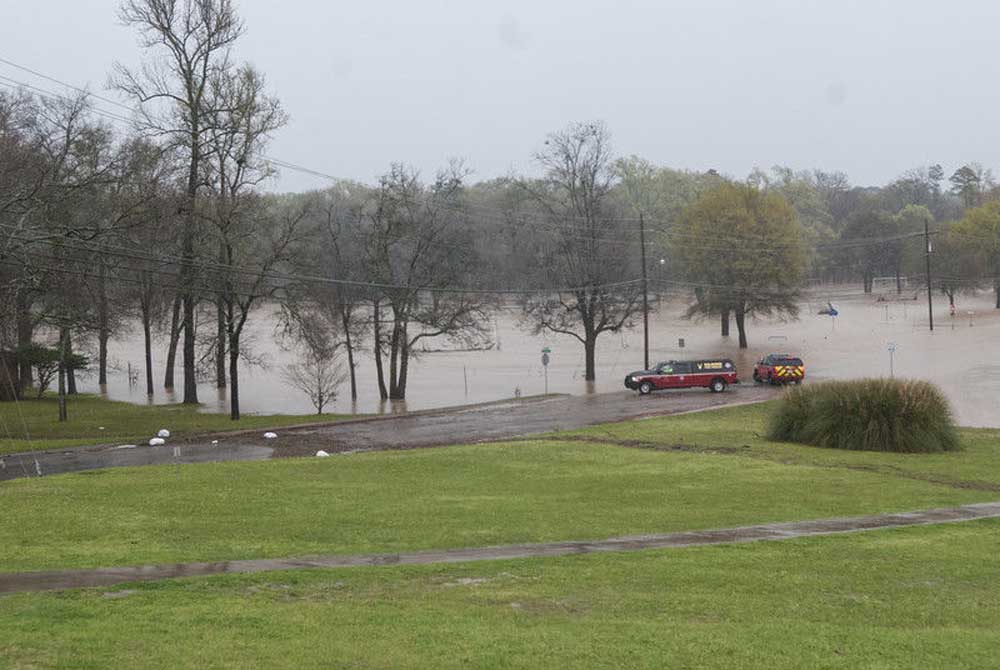Gregg County flood damage closes in on $500K, FEMA center opens
Published 7:53 am Thursday, April 14, 2016

- Floodwaters from Bighead Creek have completely submerged Meadowbrook Park on Houston Street in Kilgore on Wednesday, March 9, 2016. (Cory McCoy/Staff)
Area officials continued to tally losses from March flooding Wednesday with costs to Gregg County expected to surpass a half-million dollars.
Trending
As the Federal Emergency Management Agency opens a disaster recover center today in Kilgore, damages to homes, roads and infrastructure, as well as overtime costs for cleanup, still are being assessed.
“As of today – and this is a partial number, it’s going to far exceed this – that amount has continued from $336,965,” Gregg County Judge Bill Stoudt said. “We’ll exceed that, probably, by another $200,000. The (precinct) commissioners are still discovering weak spots in the roads, culverts that are damaged.”
That rising figure includes costs of overtime to city and county workers cleaning up and securing residents from damage caused by storms in the area March 7 through 29.
Costs to the city of Longview alone were not available, but Assistant Fire Chief Curtis Shaw reported overtime costs to his department were about $40,000.
Stoudt said County Fire Marshal Mark Moore and FEMA crews had identified 28 homes in Longview with “significant and substantial damage. And three homes in Kilgore with significant and substantial damage.”
The judge previously reported the threshold for state assistance is $450,000, a number he was confident the county will surpass.
Trending
He said northern Gregg County sustained the most damage.
“There’s some projects in Pct. 1 that are going to be pretty major, north of town,” he said.
Information was not readily available this week from Harrison and Rusk counties. However, Harrison County Fire Marshal Thomas Mock said flood waters invaded 155 homes, to greater and lesser degrees. Only a few residences were classified as destroyed, he said.
Mock also said 57 roads in Harrison County temporarily had closed during the flooding. He said compiling dollar amounts of damage would be ongoing for weeks.
The Harrison County Commissioners Court earlier this week modified county policy to allow overtime to be paid to some county employees involved in disaster recovery instead of only compensatory time.
“We’re not making a permanent change to the policy. We’re (only) trying to work through a disaster, after a federal disaster declaration, to cover our employees,” County Judge Hugh Taylor said.
Thirteen homes were damaged by the storms in Rusk County, Assistant Emergency Management Coordinator Patrick Dooley reported.
Dooley estimated 15 or 16 roads sustained minor damage, largely potholes that have been filled.
Lakes full
Waters continued to recede in river basins, bringing lakes to healthy levels.
Nearly every lake and reservoir in the Cypress Creek and Sabine River basins were 100 percent full Wednesday, according to the Texas Water Development Board.
The exceptions were Lakes Fork, Martin Creek and Murvaul, which each hovered at about 99 percent full.
Getting help
FEMA spokeswoman Robin Smith did not immediately have county-specific numbers of the disaster funds expended or expected to be paid in the three counties.
She urged residents harmed by the floods to contact the agency.
Assistance can include grants for temporary housing and home repairs as well as for medical and dental expenses.
Low-interest Small Business Administration loans also are available for businesses, rental properties, nonprofit agencies and renters.
Smith added a caution against being fooled by a somewhat misleading phrase in letters being sent to residents.
The misleading phrase is “file closed,” she said, indicating that is a bureaucratic term that does not indicate help is not available.
“Any letter you receive from FEMA, consider it a call to action,” Smith said. “It means we need additional information from you to possibly go forward and help you further.”
She also said the federal assistance is not intended to make losses whole, stressing the agency’s mandate to ensure residences are made “safe and sanitary.”
“We are not going to be able to help people get back to where they were,” she said. “That’s not how it works.”
She added FEMA home assistance is for primary residences only.
She also said applicants do not have to live within the 100-year flood plain to be eligible for help.
People hoping for help from FEMA are encouraged to register online, she said.
Disaster recovery centers such as the one opening at noon in the Kilgore Chamber of Commerce office initially were places to register, and that still is possible but not their primary function.
“It’s easier to do it from home,” she said. “The main reason for the disaster recovery center is to be able to sit down with people and answer questions. … You will be given a nine-digit file number – put that in a safe place. That’s how we know you are you (when you call).”
Staff writers Nicholas Huber, Dustin Taylor and Robin Richardson contributed to this report
FEMA disaster recovery center
When: Opening noon today
Where: Kilgore Chamber of Commerce, 813 N. Kilgore St.
Hours: 9 a.m. to 6 p.m. weekdays, 9 a.m. to 2 p.m. Saturdays
Closing: Open until interest significantly slows
Purpose: Primarily to answer questions from registered applicants
Register: At www.disasterassistance.gov
Required: Social Security number; address of damaged primary residence; description of damage: information on insurance coverage; telephone contact number; active mailing address; bank account and routing numbers (for those preferring direct deposit of assistance)
Information: Call (800) 621-3362






